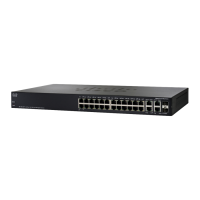Port Management
Configuring Link Aggregation
Cisco Small Business 300 Series Managed Switch Administration Guide 91
9
The switch support two modes of load balancing:
• By MAC Addresses—Based on the destination and source MAC addresses
of all packets.
• By IP and MAC Addresses—Based on the destination and source IP
addresses for IP packets, and destination and source MAC addresses for
non-IP packets.
LAG Management
Active member ports in a LAG are defined statically by explicit user assignment or
are dynamically selected by the Link Aggregation Control Protocol (LACP). The
LACP selection process selects the active member ports for the LAG after
exchanging LACP information between the local and remote devices.
In general, a LAG is treated by the system as a single logical port. In particular, the
LAG has port attributes similar to a regular port, such as state and speed.
The switch supports eight LAGs.
Every LAG has the following characteristics:
• All ports in a LAG must be of the same media type.
• To add a port to the LAG, it cannot belong to any VLAN except the default
VLAN.
• Ports in a LAG must not be assigned to another LAG.
• No more than eight ports are assigned to a static LAG and no more than 16
ports can be candidates for a dynamic LAG.
• All the ports in a LAG must have auto-negotiation disabled, although the LAG
can have auto-negotiation enabled.
• When a port is added to the original configuration of the LAG, the
configuration that existed for the port is no longer applied, and the
configuration of the LAG applies to the port. When the port is removed from
the LAG, its original configuration is reapplied.
• Protocols, such as Spanning Tree, consider all the ports in the LAG to be one
port.
• All the ports in the LAG must have the same 802.1p priority.

